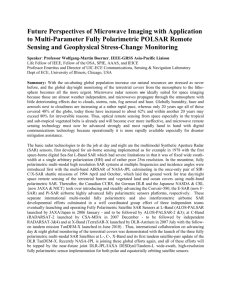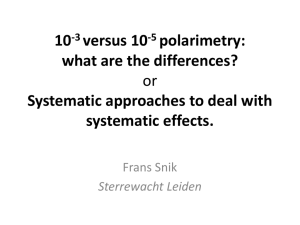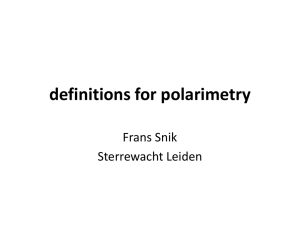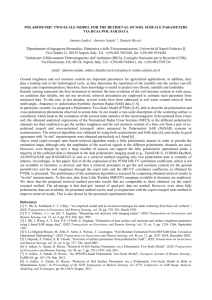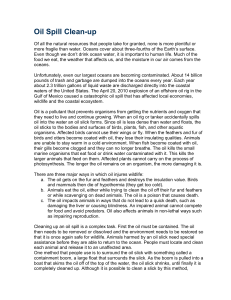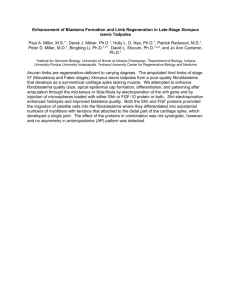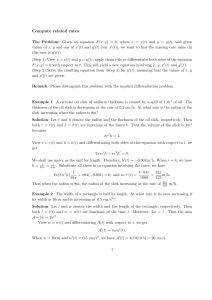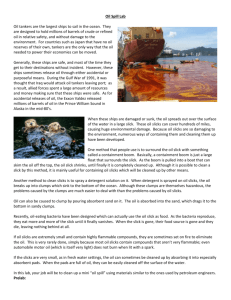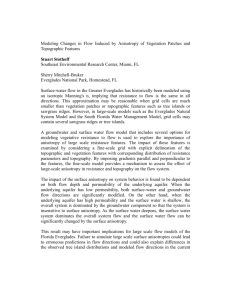improved oil slick detection and classification with polarimetric
advertisement
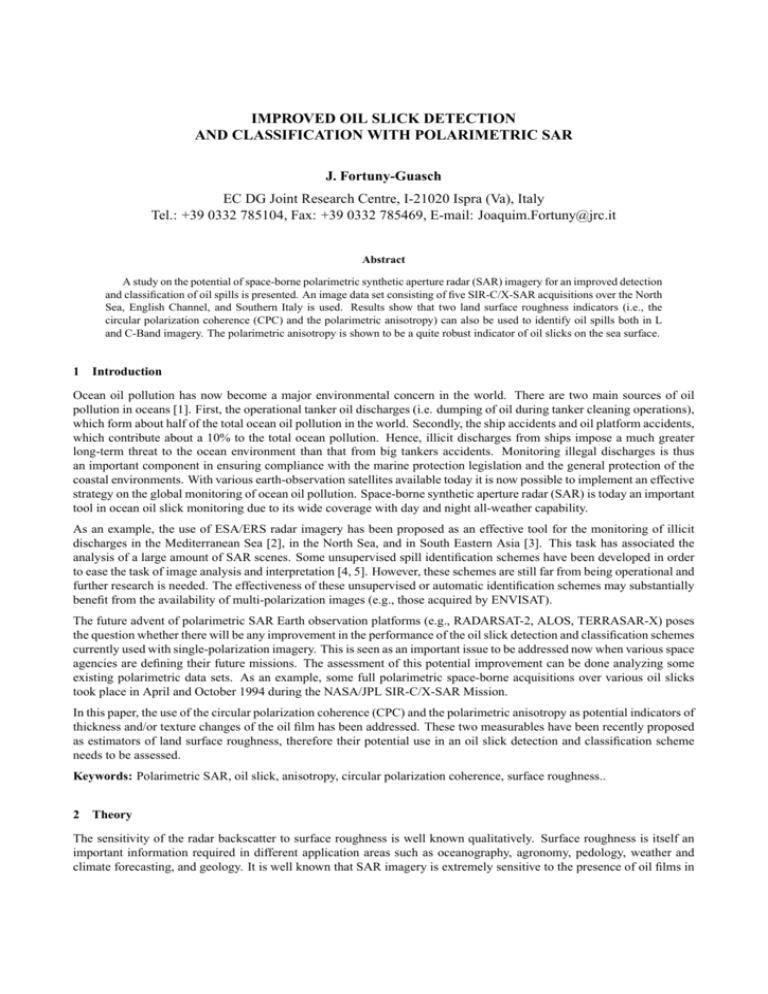
IMPROVED OIL SLICK DETECTION AND CLASSIFICATION WITH POLARIMETRIC SAR J. Fortuny-Guasch EC DG Joint Research Centre, I-21020 Ispra (Va), Italy Tel.: +39 0332 785104, Fax: +39 0332 785469, E-mail: Joaquim.Fortuny@jrc.it Abstract A study on the potential of space-borne polarimetric synthetic aperture radar (SAR) imagery for an improved detection and classification of oil spills is presented. An image data set consisting of five SIR-C/X-SAR acquisitions over the North Sea, English Channel, and Southern Italy is used. Results show that two land surface roughness indicators (i.e., the circular polarization coherence (CPC) and the polarimetric anisotropy) can also be used to identify oil spills both in L and C-Band imagery. The polarimetric anisotropy is shown to be a quite robust indicator of oil slicks on the sea surface. 1 Introduction Ocean oil pollution has now become a major environmental concern in the world. There are two main sources of oil pollution in oceans [1]. First, the operational tanker oil discharges (i.e. dumping of oil during tanker cleaning operations), which form about half of the total ocean oil pollution in the world. Secondly, the ship accidents and oil platform accidents, which contribute about a 10% to the total ocean pollution. Hence, illicit discharges from ships impose a much greater long-term threat to the ocean environment than that from big tankers accidents. Monitoring illegal discharges is thus an important component in ensuring compliance with the marine protection legislation and the general protection of the coastal environments. With various earth-observation satellites available today it is now possible to implement an effective strategy on the global monitoring of ocean oil pollution. Space-borne synthetic aperture radar (SAR) is today an important tool in ocean oil slick monitoring due to its wide coverage with day and night all-weather capability. As an example, the use of ESA/ERS radar imagery has been proposed as an effective tool for the monitoring of illicit discharges in the Mediterranean Sea [2], in the North Sea, and in South Eastern Asia [3]. This task has associated the analysis of a large amount of SAR scenes. Some unsupervised spill identification schemes have been developed in order to ease the task of image analysis and interpretation [4, 5]. However, these schemes are still far from being operational and further research is needed. The effectiveness of these unsupervised or automatic identification schemes may substantially benefit from the availability of multi-polarization images (e.g., those acquired by ENVISAT). The future advent of polarimetric SAR Earth observation platforms (e.g., RADARSAT-2, ALOS, TERRASAR-X) poses the question whether there will be any improvement in the performance of the oil slick detection and classification schemes currently used with single-polarization imagery. This is seen as an important issue to be addressed now when various space agencies are defining their future missions. The assessment of this potential improvement can be done analyzing some existing polarimetric data sets. As an example, some full polarimetric space-borne acquisitions over various oil slicks took place in April and October 1994 during the NASA/JPL SIR-C/X-SAR Mission. In this paper, the use of the circular polarization coherence (CPC) and the polarimetric anisotropy as potential indicators of thickness and/or texture changes of the oil film has been addressed. These two measurables have been recently proposed as estimators of land surface roughness, therefore their potential use in an oil slick detection and classification scheme needs to be assessed. Keywords: Polarimetric SAR, oil slick, anisotropy, circular polarization coherence, surface roughness.. 2 Theory The sensitivity of the radar backscatter to surface roughness is well known qualitatively. Surface roughness is itself an important information required in different application areas such as oceanography, agronomy, pedology, weather and climate forecasting, and geology. It is well known that SAR imagery is extremely sensitive to the presence of oil films in Figure 1 - Scattering mechanisms of an oil slick. the sea. The high sea reflectivity is due to Bragg scattering from capillary and short gravity waves. For that reason, the backscatter intensity in VV is stronger than that in HH. Slicks attenuate the short gravity waves and reduce the backscatter intensity acting as a reflectors, as shown in figure 1. The detection of slicks with single-polarization (VV) space-borne SAR has found to be optimal at small incidence angles and under moderate wind speeds (say in the range 3-8 m/s). One would expect that these validity ranges can be extended if additional images in different polarization channels were available. In that context, the optimal sensor would be a fully polarimetric space-borne SAR. The imagery used was acquired within the frame of the SIR-C/X-SAR Mission in April and October 1994. A total of five Multi-Look Complex (MLC) fully polarimetric images with both L and C-Band data were used. The available images in X-Band were quick-looks and therefore no polarimetric analysis could be applied to those. The purpose of this paper is to investigate the effect of surface roughness on polarimetric SAR data acquired by the SIRC/XSAR system with the aim of identifying the presence of oil slicks. To this end, two surface roughness indicators have been used. First, the CPC, an then, the polarimetric anisotropy derived from the Cloude/Pottier classification scheme [6]. The definition of the CPC ρrrll is as follows: < Srr · Sll∗ > ρrrll = p ∗ >< S · S ∗ > < Srr · Srr ll ll (1) wherein Srr = Sll = Shh − Svv + 2jShv 2 Shh − Svv − 2jShv . 2 (2) (3) In 1997, Cloude and Pottier developed a useful eigenvalue/eigenvector polarimetric decomposition which allows calculation of the polarimetric anisotropy [7]. The anisotropy is calculated from the using the second and third eigenvalues of a polarimetric decomposition algorithm. The anisotropy is defined by A= λ 2 − λ3 λ 2 + λ3 (4) wherein λ1 , λ2 , λ3 are the eigenvalues, ordered from largest to smallest, of the coherency matrix [T ], which is defined as (Shh + Svv )(Shh + Svv )∗ 1 [T ] = < (Shh − Svv )(Shh + Svv )∗ 2 2Shv (Shh + Svv )∗ (Shh + Svv )(Shh − Svv )∗ (Shh − Svv )(Shh − Svv )∗ 2Shv (Shh − Svv )∗ ∗ 2(Shh + Svv )Shv ∗ 2(Shh − Svv )Shv > ∗ 4Shv Shv (5) Study Areas (1) English Channel Figure 2 - X-Band quick-look image acquired over the English Channel. Humanitarian Security Unit Institute for the Protection and Security of the Citizen 6 Figure 3 - Images of the total power (left) and the CPC (right) corresponding to the scene over the English Channel (C-Band). It is worth noting that the two above roughness indicators do, however, become the same in the special case of azimuth symmetric scatter, where the hermitian coherency [T ] matrix is diagonal. 3 Results A total of five images with full polarimetric SAR data acquired were used in this assessment. The study sites included the North Sea, the English Channel, Northern Germany, and the Pantelleria Island in Southern Italy. A summary of the results obtained using the two surface roughness retrieval schemes is next. Figure 2 shows the quick-look image over the English Channel. The region of interest is indicated with a blue rectangle. The images of the total power and the CPC are shown in figure 3. These images are those corresponding to the C-Band. It can be clearly seen that, as expected, the slick area shows a lower reflectivity compared to rest of the image. It also can be seen that the CPC within the slick is lower (i.e., a smoother surface). Similar results with the CPC have also been observed in the other study areas. Figure 4 shows the quick-look image over the North Sea. In this scene there are three oil slicks that were dumped on purpose just before the image acquisition. This was an experiment organized by the University of Hamburg. These slicks are clearly distinguishable because of their unusual shape (square). There was a large slick in the center and two small ones on the sides. The images of the total power and the polarimetric anisotropy are shown in figure 5. These images are those corresponding to the C-Band. It can be clearly seen that, as expected, the slick area shows a lower reflectivity compared to rest of the image. It also can be seen that the polarimetric anisotropy is much higher within the slick. In this image, there was also a ship next to the center slick, which shows an extremely low anisotropy. Finally, figure 6 shows the quick-look image over the Pantelleria Island (Southern Italy). In this scene there is an oil slick located South of the Pantelleria Island. The associated images of the total power and the polarimetric anisotropy are shown in figure 7. These images are those corresponding to the L-Band. Again, the slick area shows a lower reflectivity compared to the surrounding sea. It also can be seen that the polarimetric anisotropy is uniquely high within the slick and nowhere else. Note that this scene also includes the southern part of the Island where there is an airport. One would Study Areas (2) Westerland (Northern Germany) Figure 4 - X-Band quick-look image acquired over the North Sea. Humanitarian Security Unit Institute for the Protection and Security of the Citizen 7 Figure 5 - Images of the total power (left) and the polarimetric anisotropy (right) corresponding to the scene over the North Sea (C-Band). Figure 6 - X-Band quick-look image acquired over the Pantelleria Island. Pantelleria Island, L-Band Data Anisotropy Changes within the Oil Slick Figure 7 - Images of the total power (top) and the polarimetric anisotropy (bottom) corresponding to the scene near the Pantelleria Island (L-Band). Security Unit Humanitarian 16 Institute for the Protection and Security of the Citizen expect that flat surfaces as those of the landing lanes could also show a high anisotropy. However, this is not the case and this result indicates that, in this very image, the polarimetric coherence is a robust oil indicator. 4 Concluding Remarks An assessment on the potential use of two surface roughness retrieval schemes for an improved detection and classification of oil slicks was presented. The imagery used consisted of five full polarimetric data sets acquired during the SIR-C/XSAR missions in April and October 1994. The analysis of the imagery showed that the anisotropy is always higher within the slick area both in L and C-Bands. Moreover, the estimates given by the circular polarization coherence (CPC) were consistent (i.e., a smaller roughness within the slick area). The presented results are preliminary and further research needs to be focused on two issues. First, the establishment the new applicability range (in terms of wind intensity and incidence angle) and robustness of the proposed polarimetric identification schemes. Second, the identification of alternative slick indicators for ENVISAT dual-polarized products (HH/VV, HH/HV, VV/HV) based on the findings presented in this paper. References [1] “Oil pollution monitoring, in ERS and its applications: Marine”. ESA Publications BR-128, vol. 1, 1998. [2] Pavlakis, P., Sieber, A., and Alexandry, S., 1996. “Monitoring oil-spill pollution in the Mediterranean with ERS SAR”. Earth Observation Quarterly, Nr. 52. [3] Jingxuan, L., Hock, L., Liew, S. C., Bao, M., and Kwoh, L. K., “Oil pollution statistics in Southeast Asian waters compiled from ERS synthetic aperture radar imagery”. Earth Observation Quarterly, Nr. 61, 1999. [4] Del Frate, F., Petrocchi, A., Lichtenegger, J., and Calabresi, G., “Neural Networks for Oil Spill Detection Using ERS-SAR Data”, IEEE Trans. on Geoscience and Remote Sensing, Vol. 38, No. 5, September 2000, pp. 2282-2287. [5] Schistad Solberg, A. H., Storvik, G., Solberg, R., and Volden, E., “Automatic Detection of Oil Spills in ERS SAR Images”, IEEE Trans. on Geoscience and Remote Sensing, Vol. 37, No. 4, July 1999, pp. 1916-1924. [6] Schuler, D. L., Lee, J. S., Kasilingam, D., and Nesti, G., “Surface Roughness and Slope Measurements Using Polarimetric SAR Data”, IEEE Trans. on Geoscience and Remote Sensing, Vol. 40, No. 3, March 2002, pp. 687-698. [7] Cloude, S. R. and Pottier, E., “An Entropy Based Classification Scheme for Land Applications of Polarimetric SAR”, IEEE Trans. on Geoscience and Remote Sensing, Vol. 35, No. 1, January 1997, pp. 68-78.
